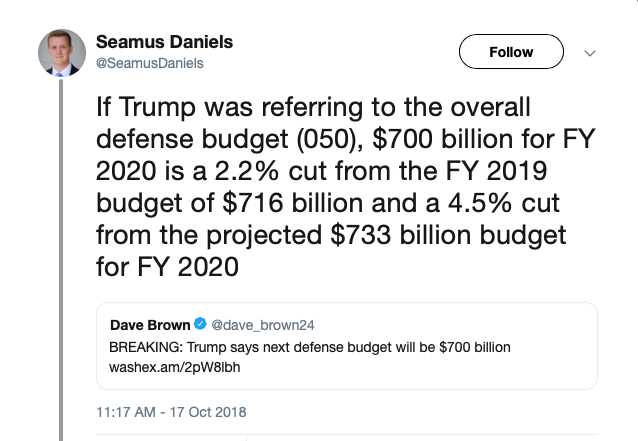In a surprise development late last week, the White House mandated that defense spending for fiscal year (FY) 2020 would be $700 billion. That is down slightly from the $716 billion approved for next year, as well as the $733 billion originally projected for 2020. This move had been foreshadowed in a cabinet meeting the week before, where Trump told all of his department chiefs to prepare to cut five percent of their budgets for the following year. It does raise a number of questions though: How much change does the $700 billion budget actually represent? Is the new figure likely to survive until FY2020 rolls around? And, most importantly, how should the Department of Defense respond to the White House’s mandate?
How significant a “cut” a $700 billion defense budget represents depends on the baseline. As Seamus Daniels, a defense budget researcher at the Center for Strategic and International Studies, noted on Twitter when the $700 billion figure was first raised, it would represent 2.2 percent less than the FY2019 budget.
Despite Trump’s order to his cabinet secretaries to cut five percent, $700 billion would be 4.5 percent less than what had been projected for FY2020. It is up for debate whether it should be considered a reduction in defense spending when reality fails to meet with projections. Seeing as the defense budget cap for FY2020 is $576 billion, it could be argued that $700 billion represents a significant increase.
Whether the $700 billion figure survives the politics to follow is also up for debate. The Pentagon has already announced publicly that it will continue to plan for a $733 billion budget, alongside the $700 budget mandated by the White House. Speaking to Marcus Weisberger of Defense One, former Office of Management and Budget official Gordon Adams suggested a higher figure was more likely:
“The White House may be saying that” — $700 billion — “but I’ll tell you from history, I’ve lived through a lot of White Houses that folded in December,” Adams said. “They had a tough position going in and at some point the Pentagon marshaled its political forces and went and had a conversation with the [president] and in the end it wasn’t what the original proposal was.”
With military pay and benefits already set, reductions in spending will have to come from cutting acquisition programs. General Joseph Dunford, chairman of the Joint Chiefs of Staff, recently suggested that the services’ proposals would undergo rigorous tests through wargamesto determine which programs would survive.
Conducting rigorous simulations to determine acquisition priorities is a wise move, but the Pentagon can go much further in prioritizing. The Department of Defense identified major power competition as its top priority in the National Defense Strategyit released earlier this year. At the same time, the president has at times expressed skepticism about the value of America’s post-September 11 wars. While there are reasons to believe he will not, the president would be best served from both a fiscal and strategic perspective, by mandating that the Pentagon begin to wind down peripheral conflicts and to focus its spending on first order strategic priorities.